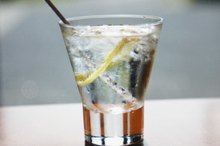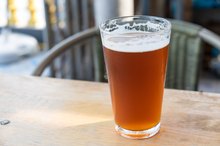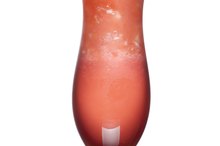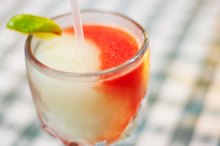Allergic Reaction Rash to Alcoholic Drinks
Allergic reactions to alcohol most often occur as an allergy to ingredients found in certain types of alcohol or to substances that alcohol is mixed with in cocktails. An inability to metabolize alcohol can also cause flushing that resembles a rash, particularly in some ethnic groups. Because allergic reactions often worsen with increased exposure, see your medical practitioner for allergy testing if you have a rash after drinking alcohol.
Alcohol Intolerance
Alcohol intolerance can cause facial flushing and nasal congestion that resembles an allergic reaction rash. Most common in Asians, alcohol intolerance occurs because a person lacks an enzyme, aldehyde dehydrongenase, which breaks down the toxins in alcohol. Rapid, pounding heartbeat and nausea and vomiting can also occur. This type of alcohol intolerance is most often genetic. Histamines, which form from fermentation or brewing processes, can also cause a reaction. Histamines are the same substances released when your body encounters an allergen.
- Alcohol intolerance can cause facial flushing and nasal congestion that resembles an allergic reaction rash.
- Histamines, which form from fermentation or brewing processes, can also cause a reaction.
Possible Allergens
What Are Gin Blossoms?
Learn More
People who have allergies to grains used to make alcohol, such as grapes, hops, wheat, barley or rye, or who have allergies to sulfites used as preservatives in wines can have allergic reactions if they drink alcohol. Mixes that contain tonic water or juice can also cause an allergic reaction with a rash. An article published in the June 2007 “Journal of Dermatology” by researchers from the University of Osaka described rashes that occurred in two people after drinking alcohol mixed with tonic water, which contains quinine.
Other Symptoms
In addition to a rash, people with an allergy to alcohol or some substances found in alcoholic drinks may experience severe reactions, with shortness of breath, throat tightening, facial swelling around the eyes and mouth, hives, low blood pressure and collapse. Severe reactions, called anaphylaxis, can be life-threatening; seek medical treatment immediately.
Treatment
Beer Yeast Allergy & Rash
Learn More
Whether you develop an allergic rash or have facial flushing due to alcohol intolerance, avoiding alcohol or the substance that you’re allergic to is imperative. If you’re allergic to a particular type of alcohol, you may be able to drink other types, but if you have an inherited intolerance, even a small amount of any type of alcohol can cause a reaction. Antihistamines can help decrease symptoms in a mild allergic reaction, but severe reactions require adrenaline in the form of an auto-injector that you can carry with you. Your medical practitioner must prescribe this. This should not be used as a backup plan for drinking alcohol; not drinking will prevent any type of alcohol-related reaction.
- Whether you develop an allergic rash or have facial flushing due to alcohol intolerance, avoiding alcohol or the substance that you’re allergic to is imperative.
- If you’re allergic to a particular type of alcohol, you may be able to drink other types, but if you have an inherited intolerance, even a small amount of any type of alcohol can cause a reaction.
Related Articles
References
- Journal of Dermatology: Fixed Eruption Due to Quinine: Report of Two Cases
- Mayo Clinic: Alcohol Intolerance
- National Institute on Alcohol Abuse and Alcoholism. Alcohol Metabolism: An Update. Alcohol Research & Health. 2007;30(1).
- Taylor B, Rehm J. The relationship between alcohol consumption and fatal motor vehicle injury: high risk at low alcohol levels. Alcohol Clin Exp Res. 2012;36(10):1827-34. doi:10.1111/j.1530-0277.2012.01785.x
- Ferré S, O'Brien MC. Alcohol and caffeine: The perfect storm. J Caffeine Res. 2011;1(3):153-162. doi:10.1089/jcr.2011.0017
- Stornetta A, Guidolin V, Balbo S. Alcohol-derived acetaldehyde exposure in the oral cavity. Cancers (Basel). 2018;10(1):20. doi:10.3390/cancers10010020
- Hadland SE, Levy S. Objective testing: Urine and other drug tests. Child Adolesc Psychiatr Clin N Am. 2016;25(3):549-65. doi:10.1016/j.chc.2016.02.005
- Stewart SH, Koch DG, Willner IR, Randall PK, Reuben A. Hair ethyl glucuronide is highly sensitive and specific for detecting moderate-to-heavy drinking in patients with liver disease. Alcohol Alcohol. 2013;48(1):83-7. doi:10.1093/alcalc/ags109
- Fillmore MT, Jude R. Defining "binge" drinking as five drinks per occasion or drinking to a .08% BAC: which is more sensitive to risk? Am J Addict. 2011;20(5):468-75. doi:10.1111/j.1521-0391.2011.00156.x
- American Association for Clinical Chemistry. Ethanol. 2018.
- Cederbaum A. Alcohol metabolism. Clinics in Liver Disease. 2012;16(4):667-685. doi:10.1016/j.cld.2012.08.002
- LabCorp, Inc. Drugs of Abuse Reference Guide. 2007.
- National Institute on Alcohol Abuse and Alcoholism. Alcohol Metabolism: An Update. Alcohol Research & Health. 2007;30(1).
Writer Bio
A registered nurse with more than 25 years of experience in oncology, labor/delivery, neonatal intensive care, infertility and ophthalmology, Sharon Perkins has also coauthored and edited numerous health books for the Wiley "Dummies" series. Perkins also has extensive experience working in home health with medically fragile pediatric patients.








